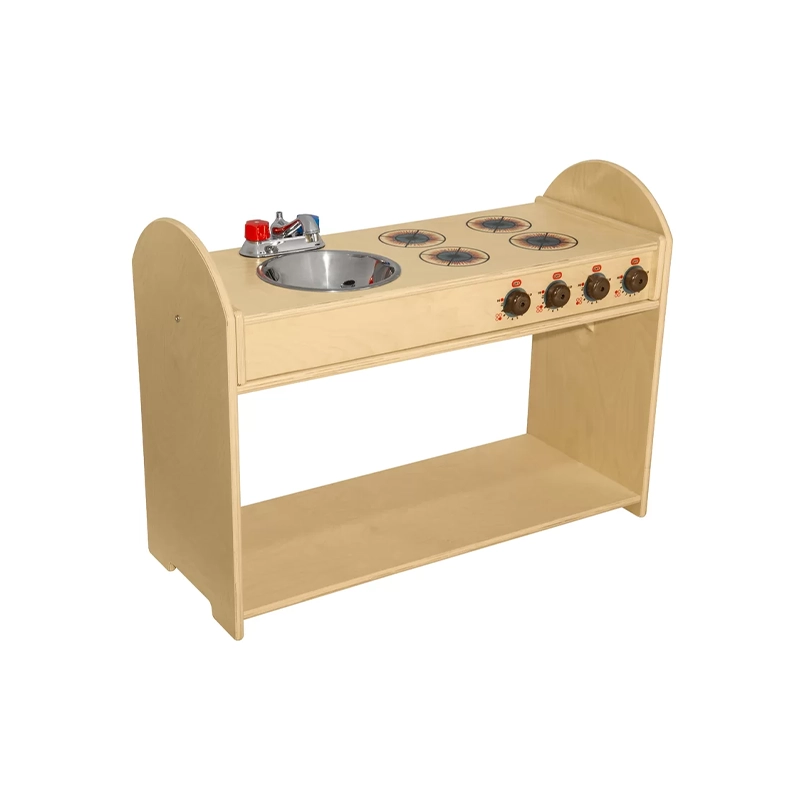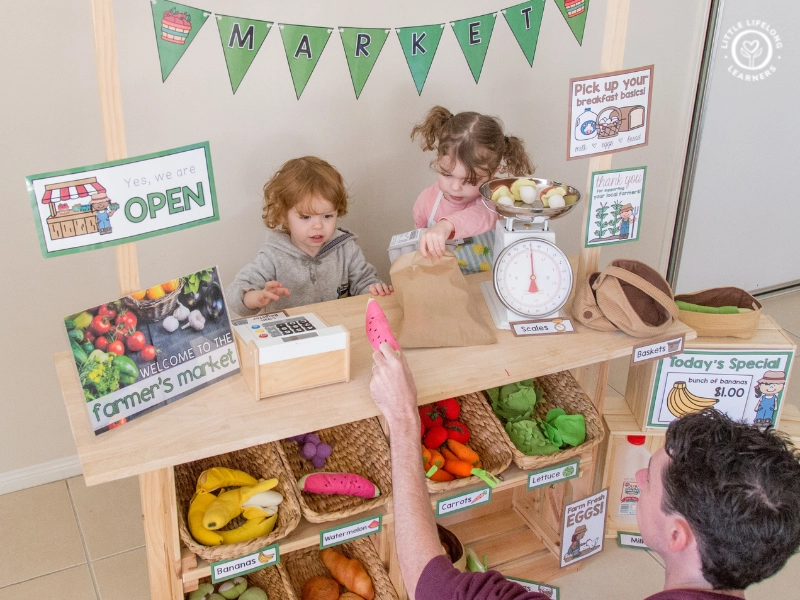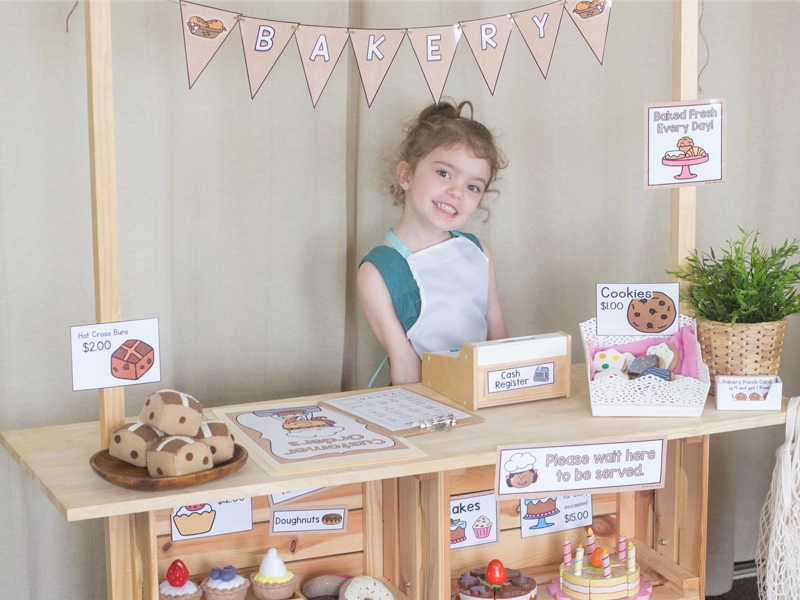
Innovative Dramatic Play Furniture for Creative Learning
Foster imagination and social development in children with our premium dramatic play furniture and accessories. From play kitchens to role-play stations, our thoughtfully designed products are built to encourage collaboration, creativity, and language development in preschool and early childhood classrooms. Crafted for safety, durability, and functionality, these pieces are perfect for any learning environment.
Types of Dramatic Play Furniture for Learning Environment
Our diverse collection of dramatic play furniture and accessories, thoughtfully designed to support imaginative role-playing in early education settings. Featuring play kitchens, market stalls, dress-up centers, and more, each piece is built for durability, safety, and engagement. Enhance your educational space with our durable and engaging dramatic play furniture, making every playtime both fun and educational.

Kitchen Center

Play Sink Appliance

Preschool Play Kitchen Set

Open Spaces Kitchen Set

Washer And Dryer

Puppet Theater

Dress-Up Island

Grocery Store Set

Kitchen Wooden Fridge

Animal Play Figures

Laundry Set

Broom and Cleaning Set
Reliable Manufacturer of Classroom Furniture
At Winning Kidz, we bring over 20 years of experience designing and manufacturing educational furniture. Our expertise in creating engaging and durable Dramatic Play furniture is built on years of understanding of how to support early childhood development. We have developed a strong reputation for delivering high-quality, child-safe products that inspire imaginative play in children while ensuring long-lasting performance.
Our Dramatic Play furniture is thoughtfully designed with the educational needs of children in mind. We focus on creating products that enhance social development, communication skills, and cognitive growth. By fostering role-playing activities, our pieces allow children to step into different roles, teaching empathy, problem-solving, and cooperation.
Safety is a top priority at Winning Kidz. Our Dramatic Play furniture is made from non-toxic, child-friendly materials that comply with rigorous safety standards. We believe furniture should be fun and engaging but also sturdy and safe for everyday use in a busy classroom. Every product undergoes thorough testing to ensure it meets the highest standards of safety and durability.
Dramatic Play Furniture Materials
The materials used in dramatic play furniture play a crucial role in ensuring the products' safety and longevity. At Winningkidz, we carefully select materials that are both child-friendly and durable. Here are some of the common materials used in our dramatic play furniture:
-
Wood Wood is durable and attractive and gives dramatic play furniture a natural feel. When sourced responsibly, it’s strong and sustainable. Common types like birch, maple, and oak are smooth and sturdy. For safety, make sure to use non-toxic, child-safe paints and finishes.
-
Kunststoff Plastic is lightweight and affordable, easy to clean, and available in bright colors. While durable, it may show wear faster than wood or metal. For safety, ensure the plastic is BPA-free and phthalate-free.
-
Fabric Upholstery Soft and comfortable for children, the fabric creates cozy environments within dramatic play areas, such as puppet theaters or play kitchens. For safety, use stain-resistant, flame-retardant, and non-toxic fabrics.
-
Laminate Laminate is easy to clean and maintain and comes in various colors and patterns. It’s durable and resistant to stains, scratches, and spills, ideal for high-traffic areas. Choose low-VOC or non-toxic laminates to avoid harmful chemicals.
-
Metall Metal provides a sleek, modern look, ideal for storage or furniture needing extra strength. It’s heavier and requires care to avoid sharp edges, with powder-coated finishes preventing rust.
-
Foam and Padding Foam is commonly used in seating and soft play furniture, offering comfort and safety. Look for CertiPUR-US-certified foam to ensure it’s free from harmful chemicals.
What is Dramatic Play?
Dramatic play is a fundamental aspect of early childhood education, promoting creativity, social skills, and emotional development. By providing children with opportunities to engage in role-playing, they learn to explore different perspectives, solve problems, and express their emotions.
Dramatic play, also known as pretend play or role play, involves children taking on roles and acting out stories or scenarios. This type of play is essential for cognitive and social-emotional growth. Whether it's pretending to be a doctor, chef, or astronaut, dramatic play helps children understand the world around them by mimicking real-life situations. Our specially designed dramatic play furniture and playsets are crafted to enhance these experiences in the classroom or playroom.
What are Types of Dramatic Play?

- Structured Dramatic Play: This type of role-play involves predefined roles and scenarios, where children engage in activities like pretending to be doctors, teachers, or parents, often using specific props such as stethoscopes or toy phones. It helps children understand societal roles, practice language skills, and develop social interaction abilities within a controlled framework. Structured play encourages children to follow specific rules or guidelines, fostering their understanding of boundaries and expectations.
- Unstructured Dramatic Play: In contrast, unstructured play is more open-ended, allowing children to create their characters, scenarios, and stories. For instance, they may pretend to be animals, superheroes, or imaginary creatures and often invent their props or settings. This type of play enhances creativity, imaginative thinking, and problem-solving abilities, as children are free to explore and shape the narrative. Unstructured play provides children with the flexibility to express themselves and develop critical thinking skills in a more fluid, spontaneous manner.

Dramatic Play Ideas for Preschool
| Dramatic Play Theme | Description | BenefitsChair Seat Height | Materials Needed |
|---|---|---|---|
| Play Kitchen | Children pretend to cook, serve meals, and manage a restaurant or kitchen. | Fosters creativity, fine motor skills, and understanding of daily routines. | Play kitchen set, food items, utensils, aprons. |
| Doctor's Office | Children role play as doctors, nurses, and patients, mimicking healthcare practices. | Develops empathy, communication skills, and social interaction. | Toy medical kits, bandages, doctor costumes, patient beds. |
| Supermarket | A pretend grocery store where children "shop" and "pay" for food items, practicing basic math and social skills. | Teaches counting, money concepts, and social exchanges. | Toy cash register, food items, shopping baskets. |
| Construction Site | Children pretend to be builders, using tools to "construct" buildings or roads. | Promotes teamwork, problem-solving, and motor skills. | Toy tools, building blocks, helmets, safety vests. |
| Fire Station | Children role-play as firefighters, putting out "fires" and saving people. | Encourages teamwork, physical activity, and understanding of community helpers. | Firefighter hats, hoses (toy), rescue equipment. |
| Post Office | A pretend post office where children sort and "deliver" letters and packages. | Builds language skills, responsibility, and an understanding of community roles. | Letters, envelopes, stamps, toy mailbox. |
Benefits of Dramatic Play in Early Childhood Development
Dramatic play helps children explore their world through role-playing. It encourages them to think critically, express their thoughts and emotions, and build social relationships. Let’s break down some of the key benefits:
Cognitive Development
Children engage in dramatic play scenarios that stimulate their imagination, language, and problem-solving skills. For example, playing "store" or "restaurant" enhances their understanding of numbers, organization, and storytelling.
Social Skills
As children play together in role-playing activities, they learn essential social skills such as turn-taking, cooperation, and conflict resolution. They also practice empathy as they step into the shoes of others.
Emotional Development
Dramatic play helps children process their emotions by allowing them to express feelings through different characters. This emotional expression can increase self-regulation and understanding of the emotions of others.
Creativity and Imagination
Pretend play unlocks a child’s imagination. It encourages them to create entire worlds from their minds, enhancing creativity and fostering the ability to think outside the box.
Supports Language Development
Through dramatic play, children naturally expand their vocabulary as they experiment with new words and phrases in various contexts. Moreover, engaging in storytelling during dramatic play helps children develop a better understanding of narrative structure, boosting their communication abilities.
Dramatic Play Activities for Preschoolers
Dramatic play is one of the most exciting and educational activities for preschoolers. It allows young children to step into various roles, explore their imaginations, and experiment with the world around them. Whether they are pretending to be doctors, chefs, or superheroes, these activities encourage creativity, communication, and problem-solving skills. By acting out different scenarios, preschoolers learn essential life skills such as empathy, social interaction, and emotional expression while having fun.

Flower Shop Dramatic Play

Post Office Dramatic Play

Farmers Market Dramatic Play

Grocery Store Dramatic Play

Camping Dramatic Play

Doctor's Office Dramatic Play
Dramatic Play for Different Age Groups
Dramatic play evolves as children grow, with different types of the game suitable for various age groups:

(1-3 years old)
Dramatic Play for Toddlers
At this stage, children engage in simple, sensory-driven play. Dramatic play for toddlers may involve simple kitchen sets, nursery furniture, and basic dress-up costumes. They begin imitating familiar adult actions, like cooking or feeding dolls.

(3-5 years old)
Dramatic Play for Preschoolers
Preschoolers engage in more complex role-playing scenarios, such as pretending to be doctors, teachers, or firefighters. The play areas can include more extensive, detailed setups like playhouses, veterinary clinics, and market stalls. At this age, dramatic play fosters social skills, cooperation, and problem-solving.

(5-7 years old)
Early School-Aged Children
Children at this stage engage in cooperative group play and more elaborate storytelling. Dramatic play areas may include themed setups like a post office, construction zones, or superhero stations. These environments encourage teamwork, negotiation, and role-taking.
Dramatic Play in Different Educational Philosophies
Dramatic play can be incorporated into various educational philosophies, each with its unique approach. Here’s how dramatic play appears across different methods:
Montessori Education
In the Montessori system, dramatic play is often child-directed. Children are encouraged to explore real-world scenarios through self-chosen activities. The focus is on fostering independence, where children can take responsibility for their play area, choosing props, and setting up scenarios.
Reggio Emilia Approach
In Reggio Emilia, dramatic play is seen as a means for children to express themselves, communicate, and negotiate with peers. Here, educators focus on creating rich, collaborative environments, with dramatic play being a vehicle for symbolic expression. Materials are often natural and open-ended, designed to provoke imagination.
Waldorf Education
Waldorf education integrates dramatic play with an emphasis on imaginative expression. Teachers often guide children’s play, using storytelling and role-playing to connect the children to artistic and emotional development. Props and settings in Waldorf classrooms are often simple and natural.
Traditional Education
In traditional educational settings, dramatic play is more structured, with teachers guiding the play activities. Furniture and play sets are often thematic and designed to fit specific learning objectives, such as understanding community roles or family dynamics. The emphasis is on social interaction and learning through structured role-playing activities.
How to Set Up a Dramatic Play Area in Your Classroom
Creating a dramatic play area is essential for fostering children's creativity, social skills, and problem-solving abilities. Here's a step-by-step guide to help you set up the perfect dramatic play space in your classroom:
1. Choose the Right Location
Select a spacious corner or dedicated area in your classroom. This area should be easily accessible but not too close to distractions, such as the noisy play area or high-traffic zones. Ensure the space allows free movement, collaboration, and easy access to all props and furniture.
2. Use Age-Appropriate Furniture
Use age-appropriate furniture that is durable and safe. For toddlers, consider low, sturdy tables and small-scale furniture. For older children, you can include larger playhouses, stage setups, and more detailed props like medical kits, kitchen sets, and cash registers.
3. Create Play Zones
Organizing the dramatic play area into distinct zones based on themes is helpful. For example, you might have a “kitchen,” a “doctor’s office,” and a “store.” Each zone should include the relevant furniture and props that encourage role-playing and imaginative exploration.
4. Add Props and Costumes
Props are essential for sparking creativity in dramatic play. Provide a variety of items such as costumes, kitchen utensils, medical tools, shopping baskets, and play money. Keep props organized in bins or shelves for easy access, and rotate them based on themes to keep the play exciting and fresh.
5. Set Clear Expectations
Once the area is set up, establish clear guidelines for how the space should be used. Explain the roles, demonstrate how to share props, and encourage children to engage with each other through collaborative play. You can introduce simple rules, like “Take turns,” “Share your toys,” and “Use kind words.”
6. Observe and Adapt
As children use the space, observe how they interact with the props and each other. Adjust the setup to ensure the play area remains engaging and supports their learning. If a particular theme isn’t sparking their interest, consider switching it up or adding new materials.
Indoor vs. Outdoor Dramatic Play Center
Dramatic play is not just limited to indoor classrooms. Both indoor and outdoor dramatic play environments offer unique benefits and challenges:

Indoor Dramatic Play
Indoor spaces tend to be more controlled, allowing for detailed setups like pretend kitchens, doctor’s offices, and shops. These spaces encourage children to engage in role-playing that mimics real-life environments. They also allow for greater customization with furniture arrangements and prop storage.

Outdoor Dramatic Play
Outdoor dramatic play spaces are typically larger and more focused on physical activities. Outdoor kitchens, playhouses, and market stalls allow children to use their imagination in more active, social settings. Outdoor play also encourages physical activity, enhancing motor skills.
Maintaining Dramatic Play Areas
Maintaining a dramatic play area is essential to ensure the furniture remains safe, functional, and conducive to learning.
-
Regular Cleaning Sanitize and wipe down all furniture and playsets regularly, especially in high-traffic areas. Use non-toxic, child-safe cleaning products to ensure safety.
-
Inspect for Damage Check all pieces for wear and tear, such as cracks, loose screws, or broken edges. Promptly repair or replace damaged furniture to maintain a safe environment.
-
Rotate Play Themes To keep the dramatic play area fresh and engaging, rotate themes and furniture periodically. This encourages children to explore new roles and keeps the space dynamic.
-
Safety Checks Ensure that all dramatic play furniture meets safety standards and is secured properly to prevent tipping. Sharp edges should be avoided, and any loose parts should be fastened securely.
-
Create a Clean and Organized Space A well-organized dramatic play area allows children to easily access materials and encourages independent play. Store costumes, accessories, and props in labeled bins for easy identification.
FAQ
What age is dramatic play for?
Dramatic play is most beneficial for children between the ages of 2 and 6. During this time, children naturally engage in imaginative role play as they explore and mimic real-world scenarios. However, older children can also participate in more complex dramatic play, which fosters deeper problem-solving and social interaction.
What are the benefits of dramatic play in early childhood?
Dramatic play in early childhood promotes creativity, language development, emotional regulation, and social skills. Children learn to express their feelings, solve problems, and understand different perspectives through imaginative scenarios. It also encourages teamwork and cooperation, which are vital for their personal and social growth.
How to support dramatic play?
To support dramatic play, provide a variety of open-ended props such as costumes, play food, tools, and furniture that encourage creativity. Create an inviting space for dramatic play in your classroom or home, and guide children when needed by suggesting roles or scenarios. Be sure to encourage collaboration and imagination during their play.
Why is dramatic play important?
Dramatic play is crucial because it helps children develop important life skills. It nurtures cognitive development by fostering problem-solving, critical thinking, and language skills. Additionally, it supports emotional development as children navigate different emotions and scenarios, and it promotes social skills such as cooperation, empathy, and communication.
How does dramatic play help a child's development?
Dramatic play contributes significantly to a child’s cognitive, social, and emotional development. It enhances language development by encouraging the use of new vocabulary and sentence structures. Socially, it teaches cooperation and conflict resolution. Emotionally, it allows children to explore different feelings and practice self-regulation.
How can I set up a dramatic play area in the classroom?
To set up a dramatic play area, allocate a corner or space in the classroom where children can engage in role-playing. Include props such as dress-up clothes, pretend kitchen items, and household tools. Design the space based on various themes such as a kitchen, hospital, or store. Keep the area organized, rotate props regularly, and ensure there is enough room for children to move freely.
How can I encourage shy children to participate in dramatic play?
To encourage shy children, start with small, low-pressure activities where they can play with one or two other children. Offer them a role that feels comfortable and familiar, like a family member or a pet. Use positive reinforcement, praise their participation, and model behaviors by engaging with them in the play. Gradually, increase the complexity of the scenarios as their confidence grows. environments and makes it easier to adapt the classroom setup.
How often should children engage in dramatic play?
Children should engage in dramatic play regularly, ideally daily or several times a week, as it is crucial for their development. It helps them practice new skills and learn about themselves and others. Providing opportunities during both structured and unstructured play times allows children to use their imagination and engage socially with peers.



